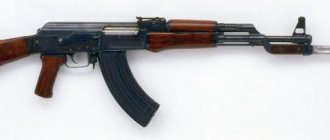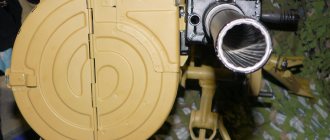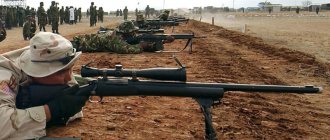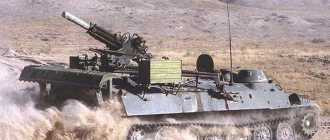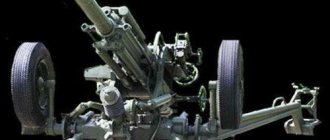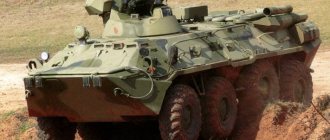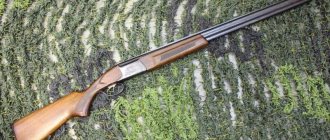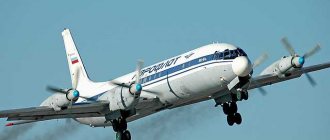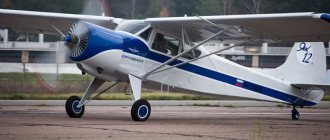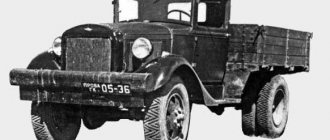Automatic machines of Russia
AKM assault rifle
Back in March 1953 - i.e., soon after the start of mass deliveries of 7.62-mm AK and AKS assault rifles to the troops - the GAU Small Arms Directorate developed tactical and technical requirements for unified models of automatic weapons - a new machine gun and a light machine gun. At the same time, it was supposed to make the basic machine gun lighter and improve the accuracy of its fire. In 1956, the “light” 7.62-mm machine guns and light machine guns of M. T. Kalashnikov, G. A. Korobov, S. G. Simonov, V. V. Degtyarev and G. S. Garanin were tested. As a result, by decree of the Council of Ministers of the USSR dated April 8, 1959, the “7.62-mm modernized Kalashnikov assault rifle (AKM)” (index 6P1) was adopted.
AKM generally retained the design of the AK assault rifle: automatic with a gas engine with a long stroke of the piston combined with the bolt frame; locking the barrel by turning the bolt with two lugs; location of the return mechanism in the longitudinal channel of the bolt frame; USM, allowing automatic and single fire and equipped with a flag non-automatic translator-fuse; assembly of all systems and mechanisms in the receiver. It is worth noting that the power of the gas engine of the automation in AK and AKM was initially determined to be excessive - together with the suspended (with large gaps) position of the moving parts of the automation, this makes it possible to ensure reliable operation of the system even in conditions of significant contamination. But this also causes an increase in the load on the system, the reaction force of the gas chamber, and vibrations. The holes for discharging spent powder gases into the atmosphere in the AKM were moved from the gas tube itself to the gas chamber.
If the AK used both a stamped receiver with a steel liner and a milled receiver, then the AKM finally adopted a receiver made from stamped parts using welding and riveting. This not only reduced weight, but made it possible to reduce metal consumption during manufacturing by 80%. The strength of the lightweight receiver cover was increased by transverse stiffening ribs.
To improve accuracy, a number of measures were implemented: a mechanical anchor-type trigger retarder was introduced into the design of the trigger mechanism (proposed by V.F. Lyuty); the impact of the bolt frame was moved from the right side to the left, which increased stability in the horizontal plane when firing. The trigger, turning after the release, hits the shoulders of the retarder twice, and the time of rotation of the trigger increases so much that by the time the shot is fired, the muzzle of the barrel, as a result of vibration, takes a position close to the position during the previous shot. The duration of the automation cycle has increased slightly, but the accuracy has improved. The VCM parts have been improved and partially changed, but in general its design has been preserved. The safety switch in the upper position blocks the trigger and blocks the slot in the receiver, blocking the rear movement of the bolt frame and protecting the mechanism from dirt and dust (the window for ejecting the spent cartridge case is blocked by the bolt frame itself). With this position of the safety switch, it is impossible to either fire or send a cartridge into the chamber. In the middle position, the translator-fuse blocks the single-fire sear, providing automatic fire (the trigger is released from cocking using a self-timer). In the lower position, the single-fire sear is released, providing single-shot fire. If the trigger, for some reason not being cocked, turns after the bolt frame, its safety protrusion will prevent the trigger from striking the firing pin.
A muzzle sleeve, a silent and flameless firing device (SFS) or an active type muzzle compensator in the form of an obliquely cut attachment can be attached to the thread in the muzzle of the barrel. The pressure of the powder gases at the muzzle, acting on the compensator protrusion, deflects the muzzle of the weapon to the left and down, reducing dispersion when firing in bursts, especially from unstable positions. Improving the accuracy of fire made it possible to increase the target range to 1000 m, although in real conditions fire is fired at shorter ranges. For shooting at dusk, glow-in-the-dark (luminescent) devices are used, worn on the rear sight and front sight.
AKM assault rifle in partial disassembly: 1 — barrel with receiver; 2 — receiver cover; 3 — bolt frame with gas piston; 4 - shutter; 5 - return mechanism; 6 — gas tube with receiver lining; 7 — fore-end; 8 - store; 9 — ramrod
The reduction in the weight of the machine gun was achieved by changes in technology. By using a light alloy sheet on an aluminum base instead of a steel sheet, the weight of the magazine was reduced. The lightweight magazine body is reinforced with stampings.
The previously used wooden parts made from birch blanks were replaced: the butt was made of plywood, the receiver was made of laminated veneer, and the pistol grip was made of plastic. Already in the mid-1960s, troops began to receive AKMs with a plastic stock (fiberglass), fore-end and receiver lining. The magazine body was now also made from plastic.
Instead of a bladed bayonet, a universal bayonet-knife (index 6ХЗ)5 equipped with a sheath with a rubber lining was introduced. Its blade had a file on the butt and a hole for connecting to the sheath (this turned the bayonet-knife into scissors), and the handle had plastic linings. The bayonet-knife is attached to the machine gun on grooves, fixed with a stop, a ring and a latch.
AKMs replaced both AK assault rifles and SKS self-loading carbines in the army. With the adoption of the AKM assault rifle and the RPK light machine gun, a 7.62-mm family was formed: based on the main components and parts, both machine guns (24 components, 95 parts) and light machine guns (33 components, 163 parts) were manufactured. At the same time, 10 units and 80 parts are unified within the family. If necessary, magazines from the RPK light machine gun can be used with the AKM. The main manufacturer of AKM was the Izhevsk Machine-Building Plant. The development of AKM production was accompanied by the improvement of technological processes in order to reduce costs and improve quality. In the process of mastering mass production, the survivability of the most critical parts increased. There are directions for automation of many manual and machine operations. A period of widespread introduction of progressive technologies began - in particular, the production of parts from precision castings using lost wax models, phosphate varnish coating of parts instead of chemical oxidation, the production of parts using powder metallurgy, and the wider use of plastics. The formation of the barrel bore of AKM assault rifles, like AK, was carried out by mandrel (pulling a punch through the bore - mandrel). Since the early 1970s, rotary forging has been used in the production of barrels. Thus, the weapon, without changing the basic design, developed and modified both in terms of design and in terms of materials and technologies. It is no coincidence that even at the beginning of the development of mass production of the Kalashnikov assault rifle, experts noted the large reserve of the system for modernization.
The thoughtfulness, comparative simplicity and peculiar elegance of the design with the widespread use of the principle of multifunctionality of parts, design and technological perfection ensured high reliability of the weapon in any conditions (including burst fire even when clogged with sand, soaked in mud and swamp water). The scale and level of development of metallurgy and the quality of weapons steel made it possible to ensure high quality weapons. Ease of disassembly and maintenance is of no small importance - in this regard, Kalashnikov assault rifles have also become a kind of standard.
AKs and AKMs have spread widely throughout the world: they are in service with the armies of more than 55 countries (the main part of them are countries in Asia, Africa, the Middle East and Latin America), and are used by armed forces and police forces in more than 100 countries. One and a half dozen countries produce their own versions.
7.62 mm cartridge mod. 1943 (7.62×39) was developed by N. M. Elizarov, P. V. Ryazanov, B. V. Semin and A. E. Ryabov. The standard cartridge is loaded with a PS jacket bullet with a steel core. There are also cartridges with tracers , armor-piercing tracer, incendiary bullets, blanks and training bullets. 7.62 mm cartridge mod. 1943 is now produced by dozens of companies around the world, which again was greatly facilitated by the prevalence and popularity of Kalashnikov weapons chambered for this cartridge.
7.62 mm assault rifles AKMN, AKML, AKMN1, AKMN2, AKMNZ
AKMN assault rifle
“Night” modifications of the AKM assault rifle have on the left side of the receiver a bar with a dovetail mount for installing illuminated and lightless night sights: - AKMN with an illuminated sight NSP-2 (“night rifle sight, second sample”), with infrared illuminator; - AKML - with an unsignaled sight NSP-3 ("night rifle sight, third sample"): - AKMN1 - with an unlit sight NSPU ("universal night rifle sight"); — AKMN2 — with the unsignaled universal night rifle sight NSPUM; — AKMNZ — with the unsignaled universal night rifle sight NSPU-3.
7.62 mm Kalashnikov assault rifle modernized with folding AKMS stock
AKMS assault rifle with folded buttstock
Simultaneously with the AKM assault rifle in 1959, its modification AKMS (index 6P4) was adopted for service, intended for arming the Airborne Forces and special-purpose units. It differs from the AKM in that it has a folding metal stock, like the AKS. The buttstock consists of two stamped rods and a folding shoulder rest; the buttstock lock is mounted on the left side of its bushing. When folded, the rest fits under the fore-end and does not interfere with holding and shooting. The weapon care accessory, unlike the AKM with a permanent stock, is carried separately.
The ballistic characteristics of the AKMS are similar to those of the AKM.
The wooden pistol grip lasted longer on the AKMS than on the AKM - the original plastic grips, unprotected from mechanical influences when the butt was folded, did not have sufficient service strength. “Night” modifications of the AKMS assault rifle correspond to the AKM modifications: - AKMSN with an illuminated NSP-2 night sight, with an infrared illuminator; - AKMSL - with non-illuminated night sight NSP-3; — AKMSN1 — with an unlit night sight NSPU; — AKMSN2 — with an unlit night sight NSPUM; - AKMSNZ - with unlit night sight NSPU-3.
AKMS assault rifle with folded stock
Tactical and technical characteristics of assault rifles: AKM / AKMS
Caliber: 7.62 / 7.62 Cartridge: 7.62×39 (model 1943) / 7.62×39 (model 1943) Weight of weapon without cartridges, kg: 3.1 / 3.3 Length without bayonet, mm: 880 / 880 Length with folded butt, mm: - / 640 Barrel length, mm: 415 / 415 Muzzle velocity, m/s: 715 / 715 Rate of fire, rds./min: 660 / 660 Combat rate of fire rds/min: 40/100 / 40/100 Sighting range, m: 1000 / 1000 Magazine capacity, cartridges: 30 / 30
Photo review of the AKM assault rifle
Design features of the 100 series
The first of the new ammunition for which the Kalashnikov was adapted was the American 5.56x45 mm cartridge. The dimensions of some parts have increased slightly, but in general the design of the AK-74M has been preserved.
And then the AK-74 was adapted to the good old Soviet cartridge 7.62x39 mm. So many of these cartridges had accumulated all over the world that machine guns adapted for it were in good demand.
Among the machines of the hundredth series there are shortened models. But they decided not to shorten the barrel as much as in the case of the AK-74U, because the gas chamber was left in the same place as in a full-size machine gun, while maintaining the full length of the piston. For this reason, this variety is often called not “short”, but “small-sized”.
Some models now have a fire mode that was not there before. This is firing in bursts of three shots. The mode switch on these models has four rather than three positions:
- on fuse;
- single shot;
- burst of three shots;
- no limited queue.
Some exotic modifications of the series do not fire bursts at all. They were planned to be intended for security structures, but they were not in demand.
Advantages and disadvantages
The Kalashnikov assault rifle is not the longest-lived among small arms models. The Colt M1911 pistol, designed by John Browning in 1908, has been used by the United States Army since 1911 and is still authorized for use by military personnel as a sidearm. But in the class of assault rifles there are no equals to Kalashnikov. The basis of success is the high reliability and laconic simplicity of the Kalashnikov.
As Mikhail Timofeevich himself said: “This is a machine gun for a soldier, invented by a soldier.” It is important that the models of the hundredth series retained the fundamental advantages of the machines of this brand. They are still simple and trouble-free. Air-cooled gas engine, magazine fed cartridges. There is simply nothing to break here. A hundred million circulation and world fame emphasize the advantages of the brand.
As for the shortcomings, they are also traditional. Experts note insufficient accuracy of fire from a Kalashnikov assault rifle. Indeed, how can one state an aiming range of 1000 m if at a distance of 800 m the average deviation from the aiming point is 80 cm? This shortcoming is indirectly confirmed by the refusal of the security forces to adopt a model with balanced automation. Perhaps, indeed, the issue is not the effect of recoil on accuracy. Perhaps its compensation does not justify the complication, increase in cost and decrease in the reliability of the system. But, undoubtedly, the Kalashnikov assault rifle of the hundredth series is an excellent, modern, highly effective weapon.
Monument to Mikhail Timofeevich Kalashnikov in the center of Moscow
2022 marks the 100th anniversary of the birth of the great Russian weapons designer Mikhail Kalashnikov. To this date, a monument was unveiled in the center of Moscow, on the corner of Oruzheyny Lane. The five-meter monument is a bronze life-size sculpture of Mikhail Kalashnikov. Mikhail Timofeevich holds a Kalashnikov assault rifle in his hands.
